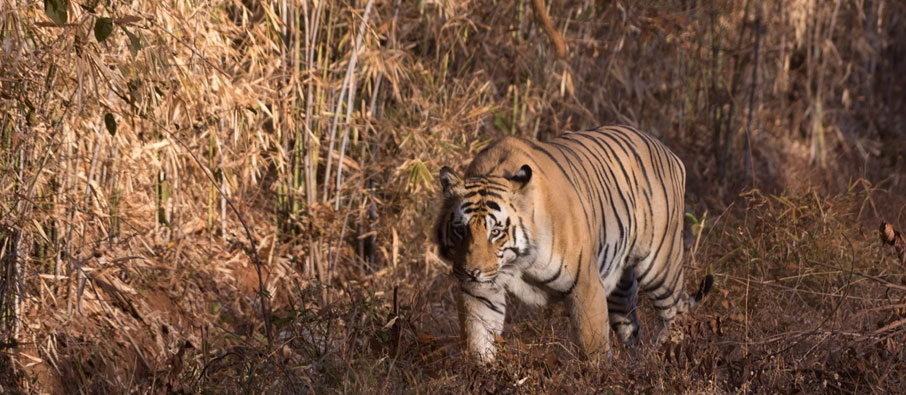Top 10 Tourist Places Near Tadoba National Park

Tadoba National Park, also known as the Tadoba Andhari Tiger Reserve, is a wildlife sanctuary in Maharashtra that draws nature enthusiasts and wildlife lovers from around the globe. While the park itself is renowned for its thriving tiger population and diverse flora and fauna, the surrounding region is equally captivating. From ancient temples and scenic lakes to vibrant cultural sites and serene nature spots, the areas near Tadoba offer a wealth of experiences for travellers.
Embarking on a safari at Tadoba National Park is an exhilarating experience, offering a chance to witness the majestic Bengal tigers in their natural habitat. To join this thrilling adventure, you will need to secure Tadoba national park tickets, which allow you to explore the park's dense forests and scenic landscapes.
Wildlife Destinations
1. Pench National Park (177 km) - Pench National Park, straddling the states of Madhya Pradesh and Maharashtra, is a lush sanctuary celebrated for its diverse wildlife and picturesque landscapes. Named after the Pench River that flows through it, the park inspired Rudyard Kipling's "The Jungle Book." A safari in Pench offers a thrilling opportunity to explore its dense teak forests and grassy meadows, where you can encounter Bengal tigers, leopards, wild dogs, and a variety of deer species.
2. Kanha National Park (298 km) - Kanha National Park is one of India's largest and most scenic wildlife reserves. Covering an area of over 940 sq km, this place is famous for its large population of Bengal tigers, barasingha (swamp deer), and a wide variety of plant and animal species. A safari in Kanha offers an unparalleled experience, allowing visitors to traverse its vast meadows, dense sal forests, and bamboo groves.
3. Nagzira Wildlife Sanctuary (143 km) - Nagzira Wildlife Sanctuary, located in the northeastern part of Maharashtra, is a pristine haven for nature and wildlife enthusiasts. This sanctuary, often referred to as the "Green Oasis of Vidarbha," is renowned for its rich biodiversity, including tigers, leopards, Indian gaur, and numerous species of birds and reptiles. A safari in Nagzira offers a thrilling opportunity to explore its dense forests and tranquil water bodies.
Forts
4. Chandrapur Fort (37.3 km) - Chandrapur Fort is strategically located at the confluence of the Irai and Zarpat rivers. The construction of this massive fort began in the 13th century under Gond King Khandkya Ballal Sah and was completed in the 16th century by King Dhundya Ram Sah. This impressive stone structure, adorned with intricate carvings, rises to a height of 15-20 feet. The fort features eight gates: Jatpura Gate (north), Anchaleshwar Gate (east), Pathanpura Gate (south), Binba Gate (west), Bagad Khidki (northeast), Hanuman Khidki (southeast), Vithoba Khidki (southwest), and Chor Khidki (northwest).
5. Manikgarh Fort (78.8 km) - Constructed in the 9th century by King Gahilu, the last ruler of Mana Naga, the fort was named after the patron deity Manikadevi and is now known as Manikgarh. The fort is a remarkable example of ancient fortification, featuring a storehouse, living quarters, a staircase leading to a water tank for storage, and more. After sunset, the fort becomes deserted, attracting wild animals that wander through the area. Visitors are therefore advised to explore Manikgarh Fort in groups, as solo visits are not recommended.
6. Ballarpur Fort (44 km) - Ballarpur Fort, also known as Ballarshah Fort, is situated in Ballarpur City on the eastern bank of the Wardha River. It was built by the Gond king Kandhakya Ballal Sah (1437-62), the successor of Ser Sah and the founder of Chandrapur city. He also discovered the holy water pond called Ankaleshwarth Tirth, believed to have healing properties for boils and tumors. Constructed from large black stones, Ballarpur Fort served as a significant defensive structure of its time. Although the original buildings are now in ruins, the fort's rectangular bastion walls remain intact.
Temples
7. Mahakali Mandir (40 km) - One of Chandrapur's prominent landmarks is the Mahakali Mandir, situated alongside the Zarpat River. Hanuman Jayanti, a special occasion, witnesses grand celebrations drawing hundreds of devotees from nearby towns to Mahakali Mandir. Inside, pilgrims pass through a tunnel leading to the sanctum sanctorum, where a revered statue of the resting Goddess awaits worshippers.
8. Balaji Mandir (14 km) - The Hari Balaji temple, constructed 350 years ago during the Bhosales' rule, stands as a prominent landmark in Chandrapur district and a highly frequented destination in Chimur. The temple houses a revered Balaji idol resembling the Venkateshwara idol of Thirupati. Annually, during the Full Moon of Magha Shuddha Trayodashi, the temple hosts the "Ghoda Yatra" festival.
Others
9. Erai Dam (28 km) - Located approximately 28 km from Tadoba, Erai Dam is a tranquil water reservoir nestled amidst hills and forests. This serene spot offers opportunities for birdwatching, picnicking, and leisurely boat rides, making it an ideal retreat for nature enthusiasts seeking peace and natural beauty.
10. Sevagram (83.2 km) Sevagram is a township situated 8 km from Wardha. Mahatma Gandhi established the ashram on the outskirts of the village, which served as his home from 1938 until his passing in 1948. The area boasts a museum dedicated to preserving artifacts from India's struggle for independence. Seth Jamnalal Bajaj, a disciple of Gandhi, generously donated approximately 300 acres of land to the ashram.